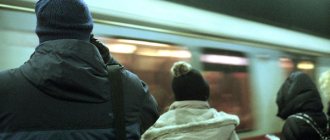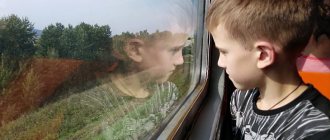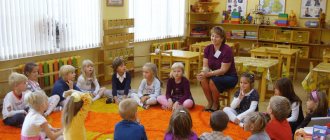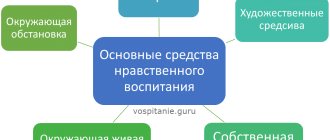Experience in life safety
Municipal preschool educational autonomous institution “Combined kindergarten No. 71 “Luchik”, Orsk”
| [Name of the organization] |
| Formation of safety in preschool children. |
| [Document subtitle] |
User User
It is well known that childhood is a unique period in a person’s life; it is at this time that health is formed and personality is formed. Childhood experiences largely determine a person's adult life. At the beginning of the journey, next to the defenseless and trusting baby are the most important people in his life - parents and educators. Thanks to their love and care, emotional closeness and support, the child grows and develops, he develops trust in the world and the people around him. You and I wish our children happiness. And all our attempts to protect them from troubles and adversity are dictated by this.
A lot can be said about the relevance of this topic and everything will be important. How to protect children's health? How can I help you understand the variety of life situations? How to teach to help each other? Analyzing the concept of “extreme”, “safety”, we will understand: but what is not a problematic situation for an adult, can become one for a child. We feel special concern for small defenseless citizens – preschool children. From the first years of life, a child’s curiosity, his activity in matters of knowledge of the environment, encouraged by adults, sometimes becomes unsafe for him. The formation of safe behavior is inevitably associated with a number of prohibitions. At the same time, adults who love and care for their children sometimes don’t even notice how often they repeat the words: “don’t touch,” “move away,” “you can’t.” Or, on the contrary, they try to explain something through long instructions that are not always clear to children. All this gives the opposite result.
Life safety issues were developed in the research of many domestic scientists (A.S. Vernadsky, M.V. Lomonosov, I.M. Sechenov). A huge contribution to solving the scientific problem of survival, self-preservation and human safety was made by the research of foreign scientists A. Adler, B. Pascal, Z. Freud. Much organizational, pedagogical, scientific and methodological work is carried out by the International Academy of Ecology and Life Safety (MANEB). The works of Russian psychologists V.V. Davydov, L.V. Zankov, A.N. Leontyev, D.V. Elkonin highlight the real diversity of ideas and approaches to the problems of personal life safety. Issues of instilling safety skills in children of senior preschool age are reflected in the scientific works of N.N. Avdeeva, O.L. Knyazeva, R.B. Sterkina, T.G. Khromtsova, K.Yu. Belaya.
Having worked in a kindergarten for a long time, you notice that children have become unindependent, lack initiative, cannot make decisions on their own, do not know who to turn to for help, do not know how to make the right decision in extreme situations, and do not know the safety rules. We agree with the opinion of many teachers that it is impossible to raise children “alienated” from life at this stage.
The main goal of instilling safe behavior in children is to give everyone the basic concepts of life-threatening situations and the characteristics of behavior in them. Safety is not just the sum of acquired knowledge, but the ability to behave correctly in various situations.
Life safety is directly related to all aspects of a person’s life: in economic, labor, moral, environmental and other spheres of life, dangers can lurk everywhere. In modern science, hazards are usually called phenomena, processes or objects that, under certain conditions, can cause damage to human health directly or indirectly.
Preschool children are inquisitive, move actively, strive for independence, and this often leads to traumatic situations. Therefore, in preschool age, it is important to create conditions in kindergarten and family that will help accumulate experience in safe behavior.
Before starting work, the following principles of work organization must be observed.
The principle of completeness. The content of the program must be implemented in all sections. If any one falls out of consideration, then children are not protected from the specific sources of danger presented in it.
Systematic principle. The work should be carried out systematically, throughout the year, with flexible distribution of program content throughout the day.
The principle of taking into account the conditions of urban and rural areas. Each child has his own experience of understanding the sources of danger, which is determined by living conditions and family upbringing.
The principle of age targeting. The content of the program in sections is used for work in different age groups.
The principle of integration. The content is woven into the content of the main comprehensive program.
The principle of continuity of interaction with a child in a preschool institution in the family. The main sections of the program should become the property of parents, who can not only continue conversations with the child on topics proposed by teachers, but also act as active participants in the pedagogical process.
Working in a kindergarten, we often encounter children's accidents: cuts, bruises, household burns, injuries. Communicating with parents and children, conducting diagnostic studies, we understand that not everyone understands the need to instill the skills of correct behavior in various dangerous situations, starting from preschool age. A significant problem is also the creation of conditions for the systematic accumulation of experience in safe behavior in kindergarten and at home.
A child may find himself in various life situations in which he may simply become confused. While working on a system for educating children about safe behavior, we tried to answer the question: “How to ensure a safe and healthy lifestyle for our children?” and, as a result, we set ourselves certain tasks:
firstly, children need to be given the necessary amount of knowledge about
generally accepted human norms of behavior;
secondly, to teach how to act consciously in a given situation,
help preschoolers master basic skills
behavior at home, on the street, in the park, in transport;
thirdly, to develop independence and responsibility in preschoolers.
It is important to teach your child to explain his own behavior
In our institution, much attention is paid to creating conditions for the high-quality implementation of educational work with children on teaching the rules of safe behavior, as one of the most important areas of the kindergarten’s activities to preserve the health and ensure the safety of pupils. But in the program itself, safety tasks are located in different sections; the developed content is offered only in older preschool age. Therefore, the program “Fundamentals of the safety of preschool children” (authors: N.N. Avdeeva, O.L. Knyazeva, R.B. Sterkina) was defined to help. It was developed on the basis of the draft temporary State Standard for Preschool Education and is the first program that is aimed at solving an important task - educating a child to behave adequately in various unexpected situations.
The content of the work to familiarize preschoolers with safety rules touches on all types of dangers in the surrounding world.
First of all, methodological tools were developed: a long-term plan was drawn up, notes for classes, excursions, conversations, etc. were selected, a diagnostic package was developed, and a plan for working with parents was drawn up
The long-term plan to ensure the safety of children contains 4 blocks:
- Home safety.
- Traffic Laws.
- Healthy lifestyle.
- Fire safety.
All contents of the work are divided into topics. I cover each topic in one or more classes; sometimes work on one topic continues in various activities. Conversations, active and didactic games, riddles, looking at paintings and posters, writing stories based on paintings, and reading works help us to uncover the topic.
The funny character Dunno is a constant assistant in teaching safe behavior. With his questions, he encourages children to solve problem situations. Children believe that they themselves teach him the rules of safe behavior. Other fairy-tale characters also come to visit us.
The most interesting classes are complex classes. Along with gaining knowledge on safe behavior, children participate in other activities: drawing, appliqué, design. The children and I drew “Good Fire” - the children were delighted, and then together they looked at how the “tongues” of the flame turned out. During the “Spark” appliqué lesson, we paid attention to the color of the fire and, to prevent trouble from happening, we extinguished the fire with pencils - “rain from a cloud”, and immediately began a conversation “How can you extinguish the fire?” Compositions were created from waste material: “Tili - bom, Cat’s house caught fire”, “The sea is on fire, a whale ran out of the sea”... Based on the results of the lessons, we organize exhibitions in groups, for example: “Three wonderful colors”, “Traffic light”, “Street” cities”, “We are going, going to distant lands.”
In my work, I widely use didactic games in which children consolidate knowledge and skills. The didactic game encourages you to be attentive and remember; children learn to explain their actions during the game and analyze the result. In the game “Dangerous - Not Dangerous,” children develop knowledge about sources of danger, precautions, and actions in dangerous situations; in the game “If the Baby Has a Cold,” knowledge about first aid is formed.
Fiction helps formulate safety rules. Children internally contribute to the heroes and experience with them all the events that happen. The kids seem to put themselves in the shoes of the heroes, illustrating the possible consequences of violating the rules of behavior. Together with the “inseparable friends” from the works of A. Ivanov, we reinforce fire safety rules, rules of behavior on the road and near bodies of water; children like these stories and they discuss the behavior of each character.
We supplement the content of classes and conversations with such catchphrases as “sound the alarm”, “trembles like an aspen leaf”, “everything in your hands is burning” and others. The selection of such phraseological units has compiled a card index of phraseological units that simultaneously develop children’s imagination, activate logical thinking and introduce an element of entertainment.
Traditionally, our kindergarten hosts a ten-day “Traffic Light” day. And this is the most favorable time for teaching children the rules of the road. We conduct excursions to intersections and roads, talk about the rules of behavior on the road and in transport, play educational games with children in a group, consolidate knowledge about road signs, read fiction and look at illustrations about transport. At the practical site of the preschool educational institution, we establish traffic rules. To do this, we use the “ABC of the Road” kit. During the “Traffic Light” ten-day period, we receive active assistance from parents who make paraphernalia for gaming activities. Don’t forget to decorate the parents’ corners: we put out folders about the rules of behavior on the city roads.
Children receive special interest and pleasure while performing work assignments. However, work activity is fraught with danger to the health of children, if the equipment used does not correspond to height, physical capabilities and careless storage, the equipment should not be heavy and traumatic. Therefore, we carefully inspect the equipment before performing the labor process, explain the rules for working with a particular tool, cards - rules - help us with this.
In everyday life, children often use scissors and pencils, so much attention is paid to the rules for handling dangerous objects. During the lesson, we remind you of the rules for safe work with scissors and glue and confirm this with our own example. For this purpose, cards have been created - rules, with the help of which children reinforce the rules of safe behavior. Similar rules have been introduced for other situations.
We plan our activities in collaboration with specialists. Together with the music director, we spend leisure time and entertainment on the topic of children’s life safety - this evokes an emotional response in children and stimulates their cognitive activity. Dramatization of the fairy tales “Cat's House” and “Confusion” develops children's creative abilities and shows that with joint efforts they can put out a fire. Children act out scenes from life while learning practical skills.
The group has accumulated a wealth of material for work in this direction: didactic games, posters, paintings, diagrams, dominoes and others. I made several didactic games, created file cabinets of logical problems and excursions. Poems help reinforce safety rules; it is easier and more interesting for children to learn the rules of safe behavior. Therefore, a selection of artistic words has been made: poems, riddles, word games.
Keep the house in order
Forks, scissors, knives,
And needles and pins
Put it in its place.
One of the forms of teaching children the rules of safe behavior is the creation of a subject-based development environment in a group, which allows them to master the rules of safety in children’s independent activities. To enrich the developmental environment, the “Magic Book” was created. The administration of the kindergarten annually holds a review - a corner competition, which encourages the creation of new educational games and aids. The group has a library of books that deal with the topic of safety and is in great demand among the children. Parents play a big role in replenishing the library.
We keep a chronicle of events and activities. We photograph all the most important and interesting things and design photo newspapers and an album with poetic accompaniment. Therefore, looking at an album is one of the children’s favorite things to do, which helps them remember the rules of behavior.
A study of the causes of injuries shows that most of them occur through the direct or indirect fault of adults.
“The vaccine against injuries is education,” as one famous scientist said. This formula is true not only for children, but also for adults. When raising a child and instilling in him the necessary skills for safe behavior in everyday life, adults must every minute set a worthy example in this regard.
As you know, both good and bad examples are contagious. Therefore, we have developed a system of working with parents, which includes the following activities:
- conversations about safety measures in a private home, behavior in the forest, in nature, around a fire;
- consultations on the basic rules for handling Christmas tree garlands, fireworks, sparklers, candles and others. I explain that adults must teach correctly: how to use household appliances, observe safety and caution measures, teach children which items can be used and which cannot. That is, parents and all adults are the most important teachers in this difficult and dangerous life.
- moving folders, stands, library.
- exhibitions on fire and road safety, where parents use their creative potential. A folder was made - moving “Fireman's Corner”; the newspaper “Fire can be different, good and terrible”, little books on traffic rules, newspapers “Beware of the Car”, “Young Pedestrian” and others. The guys proudly share how they helped their parents at home,
- participation and assistance in excursions, hikes, entertainment,
- assistance in creating a gaming environment.
“Children’s personal safety” is a frequent topic for parent meetings, the guests of which are traffic police and fire department inspectors. We are very concerned about the state of the situation on the city's roads and dangerous situations. Therefore, leaflets were created on traffic rules and measures of safe behavior in different seasons, which were presented at parent meetings.
Having secured the contents of the “Healthy Baby” section, we decided to create a “Healthy Baby” mobile folder for parents. It contains a wealth of material on breathing exercises, types of massage (legs, arms, face), and relaxation. We often use this folder in our work, and also present it to parents. We also invite parents to take part in the creation of the “Sharing Experience” section on the issues of teaching safe behavior.
Everyone knows that television is a powerful source of information for both adults and children. On our television screens you can see a lot of negative things, but there are also educational programs, the animated films “Smeshariki”, “Lessons of Caution from Aunt Owl” were immediately loved by children, this series of cartoons contains stories about safety. After watching the film, the children and I discuss the behavior of the characters and reinforce the rules. We advise parents to tune in to watch these important TV shows on weekends.
Over two years of teaching activities in the direction of educating children to behave safely, we have observed the dynamics of children’s acquisition of knowledge. Based on diagnostic indicators, we can confidently say that the work has yielded good results: children have seen progress in knowledge, skills and abilities. Children are active in joint and independent activities, inquisitive
Teaching children safe behavior means accustoming them to a certain way of life. The child must develop a defense mechanism that will automatically work at the right time.
The goal of “safe” upbringing is to instill in the child confidence in his abilities, that if he strictly follows certain rules of behavior, he will not find himself in a dangerous situation, and if this happens, he will find a way out of it.
The role of a preschool teacher is to organize a pedagogical process that preserves the health of a preschool child and instills a value-based attitude towards health. In the course of joint activities with children, the teacher, collaborating with the family, ensures the preschooler’s ascent to a culture of health.
In the concept of preschool education, solving problems related to the protection and promotion of children's health is given a leading place.
Today, preserving and strengthening children’s health is one of the main strategic objectives of the country’s development. It is regulated and ensured by such regulatory documents as
Law of the Russian Federation “On Education”
“On the sanitary and epidemiological well-being of the population.”
And also by Decrees of the President of Russia
“On urgent measures to ensure the health of the population of the Russian Federation”
“On approval of the main directions of state social policy to improve the situation of children in the Russian Federation.”
Ensuring the safety of the educational space, protecting rights, protecting the life and health of participants in the educational process are priority areas of educational policy.
Bibliography.
- Avdeeva N.N., Knyazeva O.L., Sterkina R.B. Program “Basics of safety for preschool children.”
- Loginova V.I. Program "Childhood". RGPU named after A.I. Herzen, St. Petersburg,
- Garnysheva T.P. How to teach children traffic rules? Saint Petersburg. Childhood-Press 2010
- Danilova T.I. "Traffic Light" program. Teaching preschool children traffic rules. Saint Petersburg. Childhood-Press 2009
- Gavrilova N.I., Miklyaeva N.V. Pedagogical situations as a means of activating the health-preserving environment of preschool educational institutions. Moscow 2010
- Bure R.S. what do friends do? Saint Petersburg. Childhood-Press 2004
- Pidruchnaya S. Formation of knowledge about fire safety.// Preschool education.-2006-No. 5-p.39.
- Silchenko M. Formation of healthy lifestyle habits.// Preschool education.-2006-No. 3-p.69.
- Voloshina L. Future educator and health culture.// Preschool education. - 2006 - No. 3 - p. 117.
- Cherepanova S. Life and health of children. // Preschool education - 2006 - No. 6 - p. 111.
- Khabibullina O.D. I'm walking down the street.//Child in kindergarten.-2007-No. 1-p.33.
- Semushina Yu. Be healthy. Joint activities for 3-year-old children and their parents.// Preschool education.-2007-No. 2-p.97.
- Yakimenko V. Playful recreational gymnastics after a nap. // Preschool education. - 2007 - No. 2 - p. 28.
- Borovleva A. Fire safety.// Preschool education. - 2007 - No. 4 - p. 114.
- Vdovichenko L. Child on the street.// Preschool education. - 2007 - No. 7 - p. 107.
- Reshetneva G., Abolyanina S. Formation of a value attitude towards a healthy lifestyle in older preschoolers in the process of physical education.// Preschool education. - 2008 - No. 4 - p. 54.
- Gerasimova L. Formation of a child’s value attitude towards health in the family. // Preschool education. - 2008 - No. 6 - p. 109.
- Agadzhanova S.N. How not to get sick in kindergarten. Saint Petersburg.





